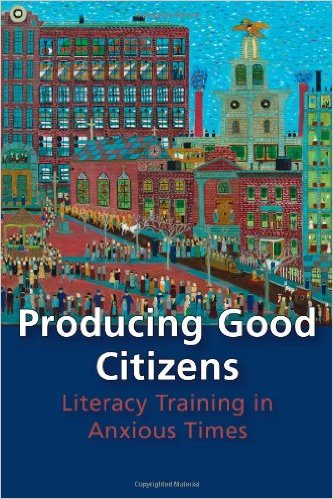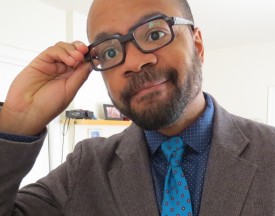Implicating the State: Black Lives, A Matter of Speculative Rhetoric
In the wake of spectacular acts of violence in which state actors have killed or legitimated the killing of Black Americans, including Trayvon Martin, Rekia Boyd, Aiyana Stanley Jones, Miriam Carey, Tamir Rice, Michael Brown, and Freddie Gray, activists have invoked the phrase “Black Lives Matter” to uphold the value of Black life in the face of its apparent devaluation. Following the dissemination of the maxim as a hashtag and in grassroots mobilizations, supporters and detractors have reiterated this mantra, occasionally altering it in order to articulate distinct, sometimes competing, understandings of violence and state power. The President said Your Life Matters in his 2015 State of the Union Address. A Twitter user posited Blue Lives Matter to defend police officers’ actions. After coining the phrase along with her colleagues Alicia Garza and Opal Tometi, Patrisse Cullors has insisted on All Black Lives Matter to resist marginalizing tendencies among activists that propagate the notion that cisgender, heterosexual Black men are the sole targets of racial profiling. Sometimes, as a rebuttal to the discomfiting reminder that Black vulnerability to state violence maintains White supremacy, White interlocutors will proclaim that #AllLivesMatter on social media. These confounding circumstances have made it vital to continue saying “Black Lives Matter” in conjunction with actions that seek to turn the tide of a violent history in which Black life does not seem to matter to representatives of American social institutions and political leadership. This essay analyzes the prototypical utterance of “Black Lives Matter,” based on firsthand accounts of its origins, in order to argue for applications of speech act theory that allow us to assess the efficacy of rhetoric that purports to confront the problem of state-sanctioned lethal violence against Black people.
I interpret the implications of saying “Black Lives Matter” in terms of performativity, rhetoric, and pragmatics, which come together to shed light on politics and communication in new ways in recent years. Scholars and teachers can learn how to make more effective discursive interventions against racism, in educational contexts and in everyday life, from the organic intellectual practice of the Black women who coined “Black Lives Matter.” By contextualizing the phrase’s meaning in the work of activists engaged in ongoing social movements, we can provide more salient examples of the work rhetoric performs in contemporary politics, and we can maintain attention to the role of institutions—as well as to our own roles as speakers and listeners—in determining the meaning of what we say and, by extension, what we do to each other. By recognizing how this speech act is distinctive in its aims and effects, we can participate in a rigorous critique of the state and the acts carried out with its legitimation. By understanding that the efficacy of this statement is speculative in nature—its implications are uncertain—we might conceptualize the choice to use the phrase in the way its originators intended as a matter in which we have some agency as custodians of its meaning.
Spectacle, Violence, and Performativity
One factor that accounts for disparate reactions to the assertion “Black Lives Matter” and for the structural critique it entails is the commonplace tendency to identify racism as a character flaw, a matter of individual dispositions. This manner of thinking often leads White interpretants who do not want to see themselves as racist to take a defensive posture when their interlocutors subject whiteness to scrutiny. Highlighting the shortcomings of individualistic accounts of racism, scholars and teachers who practice a “pedagogy of whiteness” scrutinize individualistic accounts to emphasize how focusing on personal culpability for racist acts “removes non-overtly racist individuals from feeling any responsibility for addressing diversity issues since they do not see their role in larger discriminatory practices” (Hytten and Adkins 444). Whereas individuals may hold themselves blameless for racist acts perpetrated in the past or by other persons, a thorough appreciation of rhetoric reminds us that the positions of bystanders, spectators, and listeners are integral to the process of making meaning and inspiring action. When motivated to move from the sidelines into active positions in determining what the ongoing legacy of racism means, present-day White interlocutors sometimes enter into critical discourse on racism through the process of identification that Melanie Kill describes as “uptake” (218). Eventually, by internalizing a desire to resist racism, those erstwhile bystanders can learn to take up “positive white identities.”
“Black Lives Matter” is a critical formulation of the call to resist racist violence because it places Black subjects at the center of its analysis and it implicates the state. Unlike the imperative of cultivating positive White identities, which emphasizes individual transformation, it employs a collective mode of address. While sustaining diverse coalitions is a part of working toward social transformation, satisfying individual coalition members in emotional and cognitive terms (e.g., cultivating empathy and pursuing common interests) is an insufficient strategy on its own, because it relies on the notion that allies’ desire to avoid feeling bad will motivate them toward constructive action (Jurecic 11). With personal rather than structural goals in mind, the actions to which allies commit will be those that assuage their own concerns even if they leave the status quo intact.
Institutions may embrace a more systematic understanding of racism in official pronouncements, but the rhetoric with which they do so matters as well. Sara Ahmed cites a recent pattern in the United Kingdom, where “(in particular, the police) have either recognized themselves as being institutionally racist or have adopted a definition of institutional racism within their race-equality policies” (106). She refers to these statements as “nonperformative,” because although they acknowledge responsibility for past errors, they disavow the need for further redress (107). Further, Ahmed cites the inaction countenanced by such statements as a feature, rather than a flaw: “In my model of the ‘nonperformative,’ the failure of the speech act to do what it says is not a failure of intent or even circumstance, but it is actually what the speech act is doing” (105). In politics, we judge speakers’ pronouncements as ineffectual when they dispense with action in favor of “mere rhetoric.” This critique underlies political scientist Cathy Cohen’s call to distinguish between actions that offer substantively affirmative responses to the question “Do Black lives matter?” and gestures of “performative solidarity” that consist only of saying “Black Lives Matter.”
Since taking up J. L. Austin’s defining work of speech act theory, How to Do Things With Words, critics have devoted heightened attention to the political possibilities of language that not only means something but also does what it says. Although performative utterances sometimes fail to bring about their desired effects, it is instructive, in political matters, to attend to the implications of pronouncements that are both rhetorical and speculative in nature. Examples of these utterances include provocations, incitements, and assertions; these aspirational, defiant, and even utopian statements can motivate social action and thereby cross the threshold between meaning and doing. By asking what is at stake when speakers use the phrase “Black Lives Matter,” in its original context as well as in its subsequent iterations, we might work toward understanding—but not prescribing—what this rhetorical act makes possible.
Making Speech Acts Meaningful
When Alicia Garza read reports of George Zimmerman’s acquittal for killing Trayvon Martin in July 2013, she drafted a Facebook status decrying the injustice. Her initial message, which she describes as a “love letter to Black folks,” culminated thusly: “Black people. I love you. I love us. Our lives matter” (King). Garza’s friend, prison abolition activist Patrisse Cullors, reiterated the message of grief and hope, adding the hashtag #blacklivesmatter, on Facebook. From an expression of shared condolences that Cullors shared on the Facebook walls of her friends, which they in turn shared with their contacts, #blacklivesmatter became the first term of, in Garza’s words, “a proposition: ‘twin, #blacklivesmatter campaign? can we discuss this? I have ideas. I am thinking we can do a whole social media/all out in the streets organizing effort’” (King). After the pair contacted a third interlocutor, Opal Tometi of the Black Alliance for Just Immigration, the three women coined the hashtag #BlackLivesMatter, and it spread virally on Twitter before appearing on banners at demonstrations across the country. Mobilizations of diverse participants under the herald of #BlackLivesMatter have underscored the inherent value of coalitions among constituencies otherwise divided by class, color, citizenship, age, gender, and ability. In a PBS interview, Tory Russell of Hands Up United highlighted this difference between the current activism and the conventions of familiar American social movements:
“This is not the Civil Rights Movement . . . [T]his is the oppressed people’s movement. So when you see us, you’re gonna see some gay folk, you’re gonna see some queer folk, you’re gonna see some poor black folk, you’re gonna see some brown folk, you’re gonna see some white people, and we’re all out here for the same reasons.”
Through this expansive formulation, like Cullors’s reminder that “All Black Lives Matter,” these organizers intend to ward off tendencies toward hierarchy along gendered and sexual lines and instead return attention to the mantra’s origins in the variegated, heterogeneous context of Black women’s discourse (Henderson 5). In Tometi’s words, “The movement is about creating a multiracial democracy that works for all black folks. We have to stand up for all marginalized people—black transgendered [sic] people, black immigrants, black people struggling in poverty” (Milloy B1).
The ongoing deaths that result in reminders that “Black Lives Matter” substantiate the speakers’ belief in the statement’s necessity and attest to the urgency of the demands it conveys. Through its utterance and repetition, users of the phrase form a circle of protection to encompass those interlocutors for whom the utterance is imperative. In addition, the assertion, as the particular form this utterance takes, anticipates a response to its conditions of possibility—even if it cannot name that response in advance. As a statement made to and for someone, the assertion is a particular kind of speech act: “grounded in an occasion, an assertion is a purposive act entraining very real effects” (Munro 27). In the case of “Black Lives Matter,” the assertion calls for a change in the conditions that make its utterance necessary. It is at once axiomatic and speculative; grounded in the occasion of state-sanctioned violence, the statement is not just the invocation of a self-evident truth in which the speaker avers belief but also, in a special sense, a promise to uphold this truth, to make the implications of knowing it manifest in the future in ways that are not apparent in the present. Understanding the hope with which Garza, Cullors, and Tometi coined “Black Lives Matter” requires that we link a race-conscious analysis of past state violence to ongoing, collective responses in the present and future.
As an assertion, “Black Lives Matter” entails both an “illocutionary force”—the deed of professing solidarity that is more or less accomplished in the act of saying these words—as well as some “propositional content” or “perlocutionary effects” (Lycan 179). There is a speculative quality to this aspect of the statement’s meaning. As a perlocutionary act, its implications are inchoate in the moment of its utterance and can only be fulfilled through further actions. Andrew Munro calls the investigation of this speculative dimension of meaning “perlocutionary inquiry” (31). I would argue that it is their simultaneously rhetorical and speculative nature that makes perlocutionary acts so confounding for speech act theory. Making perlocutionary utterances requires a speaker to speculate about the listener’s response: “a listener’s passive comprehension of a speaker’s meaning is a ‘scientific fiction,’ as all real and integral understanding constitutes nothing other than the initial preparatory stage of a response (in whatever form it may be actualized)” (Bakhtin qtd. in Kill 220). Thus, perlocutions do not necessarily assume that listeners will demonstrate a successful “uptake” of their meaning; rather, they give listeners the responsibility to make them meaningful.
The Meanings Speech Acts Make
Perlocutionary utterances like “Black Lives Matter” not only do what they say (assert a belief), but they also aim to persuade, and all persuasion runs the risk of failure. Whether I mean it or not, I might say “Black Lives Matter” enjoining you to accept or reject my statement’s implications. Such is the power of the assertion “I love you”—which we now know to be implicit in the prototypical utterance of “Black Lives Matter”—that it forms the basis for Jacques Derrida’s signature contribution to the theory of performativity (Miller 232). In similar fashion, fiction writer and critic Samuel Delany notes the discourse of desire is so powerful and the “terror of rejection” so great that actually saying to the object of one’s desire “I like you. Do you like me?” seems unthinkable (16). These meaningful assertions are fraught with the risk of conveying truths about the speaker—truths that might place one at odds with the state or with one’s beloved—and implicating the addressee in their consequences.
To profess one’s love for Black life in the face of armed indifference engages a speaker and addressee in a profound undertaking. It is daring to make the statement’s truth known, its presence felt, by the state and the public and thereby challenging their power to devalue Black lives through violence and its legitimation; however, depending on the speaker’s identity and the listener’s judgment, any given speech act can take on radically different meanings. “It is normal,” empirically speaking, “for different hearers to assign to the same speaker a high, moderate, or low credibility” (Marcu 1727). Furthermore, “the relevant features of the speaker,” which qualities of the speaker will facilitate a given listener’s assent and which qualities will mitigate persuasion, “are influenced by the groups to which the hearer belongs or wants to belong.” We are all addressed in various ways by the phrase “Black Lives Matter,” whether we are likely listeners, skeptics, or joining in as “unintended hearers” (Kang 61). Part of what is at stake in the utterance is the listener’s willingness to join a struggle initiated by Black women and to maintain the rigorous commitment to inclusion it entails. Our varied investments in state power, the groups to which we belong or want to belong, play a critical role in what we are willing to demand of the state as well.
To believe that “Black Lives Matter” means something unique to each of us and to reiterate it accordingly is to join in the risky undertaking that Charles Peirce called “speculative rhetoric,” to act on the knowledge that the implications of our words are subject to “different uptakes effected by rhetorical agents with diverse pasts and disjunctive present purposes” (Munro 31-2). We may choose to reject the proposition that saying “Black Lives Matter” necessarily implicates the state, or even try to deny the urgency of saying it, but that will not make the utterance meaningless. Not all speakers and listeners acknowledge that “#BlackLivesMatter as a rallying call was meant to undermine all forms of state violence” against all Black people (Cullors). But we can choose to make that what it means.
Works Cited
- Ahmed, Sara. “The Nonperformativity of Antiracism.” Meridians: Feminism, Race, Transnationalism 7.1 (2006): 104-26. Print.
- Allen, James, and John Littlefield. Musarium: Without Sanctuary: Lynching Photography in America. Twin Palms Publishers, 2000-2005. Web.
- Berman, Mark, and Wesley Lowery. “The 12 Key Highlights from the DOJ’s Scathing Ferguson Report.” Post Nation. The Washington Post, 4 Mar. 2015. Web.
- Cohen, Cathy. “#DoBlackLivesMatter? On Black Death and LGBTQ Politics.” CLAGS: The Center for LGBTQ Studies. The Graduate Center of the City University of New York. 12 Dec. 2014. Kessler Award Lecture.
- Cullors, Patrisse. “All Black Lives Matter: #BlackLivesMatter Co-founder Patrisse Cullors on De-Centering Cis-Sisters and Brothers and Making the Movement Trans-inclusive.” Ebony. Ebony Magazine, 18 Dec. 2014. Web.
- Delany, Samuel. “The Rhetoric of Sex/The Discourse of Desire.” Shorter Views: Queer Thoughts and the Politics of the Paraliterary. Middletown, CT: Wesleyan UP, 2000. 3-40. Web. 31 Mar. 2015.
- Gadbois, Barry (BarryGadbois). “Cops have a right to defend themselves and an obligation to protect you. #BlueLivesMatter #Ferguson.” 25 Nov. 2014, 12:19 a.m. Tweet.
- Henderson, Mae. “Speaking in Tongues: Dialogics, Dialectics, and the Black Woman Writer’s Literary Tradition.” The Scholar and Feminist XXX: Past Controversies, Present Challenges, Future Feminisms. Spec. issue of Scholar & Feminist Online 3.3/4.1 (2005). Web. 6 Aug. 2015.
- Hytten, Kathy, and Amee Adkins. “Thinking Through a Pedagogy of Whiteness.” Educational Theory 51.4 (2001): 433-50. Print.
- Ifill, Gwen. Interview with Molly Greiber, Tory Russell, and Jessica Pierce. “Why Do You March? Young Protesters Explain What Drives Them.” Washington Week. 9 Dec. 2014. Web.
- Jurecic, Ann. “ Empathy and the Critic.” College English 74.1 (2011): 10-27. Print.
- Kang, Qiang. “On Perlocutionary Act.” Studies in Literature and Language 6.1 (2013): 60-4. Print.
- Kill, Melanie. “Acknowledging the Rough Edges of Resistance: Negotiation of Identities for First-Year Composition.” College Composition and Communication 58.2 (2006). Print.
- King, Jamilah. “#blacklivesmatter: How Three Friends Turned a Spontaneous Facebook Post into a Global Phenomenon.” The California Sunday Magazine. California Sunday, 1 Mar. 2015. Web.
- Kurzon, Dennis. “The Speech Act Status of Incitement: Perlocutionary Acts Revisited.” Journal of Pragmatics 29 (1996): 571-96. Print.
- Lycan, William. “Speech Acts and Illocutionary Force.” Philosophy of Language: A Contemporary Introduction. London, Eng.: Routledge, 1999. 173-86. Web. 23 Mar. 2015.
- Marcu, Daniel. “Perlocutions: The Achilles’ Heel of Speech Act Theory.” Journal of Pragmatics 32 (2000): 1719-41. Print.
- Miller, J. Hillis. “Performativity as Performance/Performativity as Speech Act: Derrida’s Special Theory of Performativity.” South Atlantic Quarterly 106.2 (2007): 219-35. Print.
- Milloy, Courtland. “Marginalized Black Women Are at Heart of the Matter.” Washington Post 20 May 2015: B1. Print.
- Munro, Andrew. “Reading Austin Rhetorically.” Philosophy and Rhetoric 46.1 (2013): 22-43. Print.
- Obama, Barack. “Clip from 2015 State of the Union Address.” C-SPAN. 20 Jan. 2015. Web. 4 June 2015.
- Trawalter, Sophie, Kelly Hoffman, and Adam Waytz. “Racial Bias in Perception of Others’ Pain.” PLoS One 7.11 (2012): n. pag. Web. 6 Aug. 2015.
- Worthen, W.B. “Drama, Performativity, and Performance.” PMLA 113.5 (1998): 1093-107. Print.
Cover Image Credit: https://www.flickr.com/photos/44550450@N04/20000371679/




 andré carrington, PhD., is Assistant Professor of African American Literature at Drexel University. He has contributed to African & Black Diaspora, Callaloo, and A Companion to the Harlem Renaissance. His first book, Speculative Blackness: The Future of Race in Science Fiction, will be available from University of Minnesota Press in 2016.
andré carrington, PhD., is Assistant Professor of African American Literature at Drexel University. He has contributed to African & Black Diaspora, Callaloo, and A Companion to the Harlem Renaissance. His first book, Speculative Blackness: The Future of Race in Science Fiction, will be available from University of Minnesota Press in 2016.